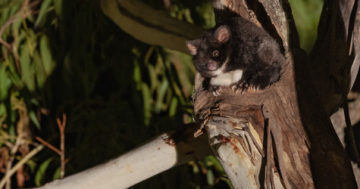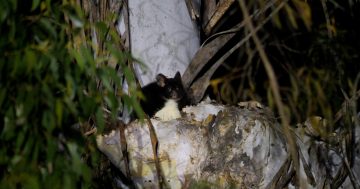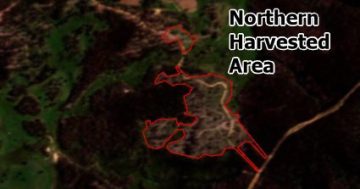
Dr Larraine Larri (left) and Bron Vost air their view at endangered gum tree Big Spotty. Photo: Knitting Nannas.
Milton-Ulladulla nannas are going into battle for the future of giant gum tree ”Big Spotty”.
The nannas – armed only with their knitting needles – made the trek out to visit the largest spotted gum in the world for World Environment Day on Monday (5 June).
”SpokesNanna” Dr Larraine Larri said they wanted a guarantee Big Spotty and the compartment it lives in will be protected from logging.
“Big Spotty herself is protected since 2005, but we know so much more now about how interconnected forests are,” she said.
“With giant trees, their roots go down considerably and out for hectares, so once you start stripping away the trees around them, you create soil erosion and you expose the tree to the elements because you’ve taken away the canopy around it.
“Big Spotty has been around for about 500 years, flowering and seeding the forest around her. All those saplings and mature trees are her children, and they’re all interconnected.”
In February the Brooman State Forest Conservation Group first raised the alarm about Big Spotty’s compartment, between Batemans Bay and Ulladulla, being scheduled for logging in September.
The group pushed for the Shoalhaven City Council to take action – and the council did.
On April 24, Shoalhaven City Council voted unanimously to ask the NSW Government to remove the section of forest Big Spotty lives in from the Forestry Corporation of NSW’s logging schedule, and to develop a long-term plan to protect the area.
The NSW Forestry Corporation announced it would delay logging in the area from September 2023 to mid-2024.
But it’s now June, and with no firm commitment from Forestry to protect Big Spotty’s entire compartment, the Milton-Ulladulla District Knitting Nannas group – or ”loop” – decided it was time to put their needles to good use and poke about.
“The locals took us in by four-wheel-drive over some very muddy, bumpy roads before we clambered down the steep slope to Big Spotty,” Dr Larri said.
“We were up for it, even if some of us have walking sticks!
“We sang a gorgeous song for Big Spotty and wrapped her with nanna love – a 12-metre woollen crocheted ribbon in the nannas’ favourite colours: yellow, black and red.
“Our nanna colours symbolise sunflowers, love hearts, solidarity with Lock the Gate and First Nations peoples.”

Soaring Big Spotty dwarfs the nannas. Photo: Knitting Nannas.
If you haven’t heard of the Knitting Nannas before, they’re a force to be reckoned with.
Forged during the campaign to keep the Northern Rivers free of fracking, a group of older women became tired of being asked to take the minutes and make the tea.
A non-violent direct-action training group was the last place they expected to be told to fit into traditional gender roles.
So they took matters into their own hands, delivering vital intelligence to organisers.
Since then they’ve expanded to about 40 ”loops” Australia-wide, going in to bat for local environmental issues.
Dr Larri, who before becoming a member did her PhD on the Knitting Nannas, said most of the women involved had never taken part in activism before.
“We care about future generations,” she said.
“We’re an evidence-based movement, here to protect the land, air and water for them, to support other protesters and give hope to anyone who wants to be visible and vocal about their concerns around climate change.
“There’s a lot of eco-anxiety, there’s a lot of problems, a lot of issues, but we’re showing anyone can be an activist, and that gives hope.
“And we have a laugh at ourselves – when you see a group of older women dressed up, it gives people a bit of a smile.”
Dr Larri said the Knitting Nannas wanted two commitments from the State Government: first, to commit to protecting Big Spotty’s compartment forever, by making it part of the Murramarang National Park; and second, to protect our unique bushland and end native forest logging.
“Listen to your nanna,” Dr Larri said.















